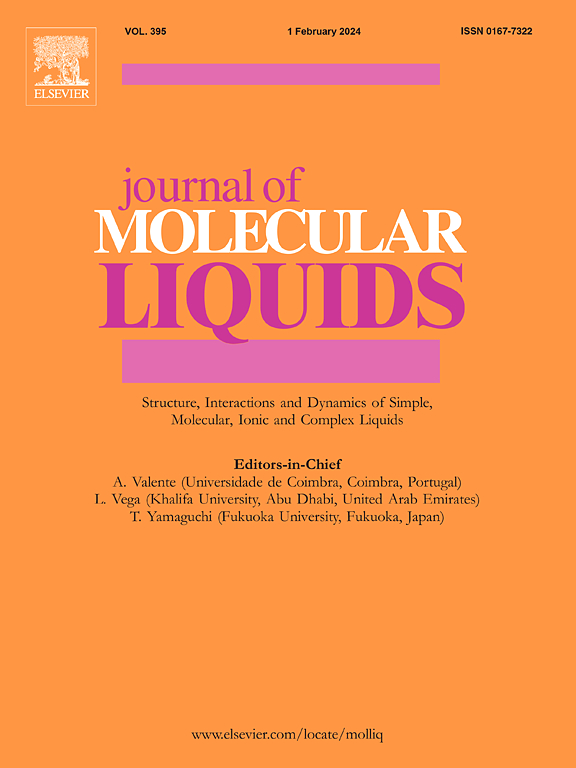Insights into antimicrobial potential of functionalized thiazoles: In vitro and in silico analysis
IF 5.3
2区 化学
Q2 CHEMISTRY, PHYSICAL
引用次数: 0
Abstract
Thiazole heterocycles hold significance in drug design and discovery. Thiazoles constitute effective antimicrobial drugs like Cephalosporins (Antibacterial) and Thiabendazole (Antifungal). The presence of sulfur and nitrogen atoms turn thiazole significant motif for co-ordination purposes improving therapeutic efficacy. Similarly, substitution of thiazole ring generates biosafe analogues with desired pharmacokinetic profile. Therefore, thiazole motif serves as versatile tool for hit to lead generation and subsequent optimization. In this context, the current review (2021–2023) contains synthesis, in vitro antimicrobial screening and molecular docking analysis of thiazole based heterocycles. The core objectives include: (i) To discuss thiazole based available drugs and therapeutic candidates under clinical trails; (ii) Efficient strategies for the synthesis of thiazole heterocycles; (iii) Recent advances in antibacterial and antifungal potential of thiazole derivatives; (iv) Structure activity relationships (SARs) of antimicrobial thiazole analogues; (v) Molecular docking (MD) analysis of the potent antimicrobials to gain insight into the intermolecular interactions present between thiazole and the target protein. Briefly, the efficient synthetic strategies include condensation reactions, multicomponent reactions, microwave irradiation, nanocatalysis, cycloaddition reactions and hemi synthesis. Consequently, the screened thiazole derivatives showed potency against various bacterial and fungal strains with some of the hybrids having better inhibition against the resistant strains than the standard drugs. Thiazole hybrids exhibited higher antimicrobial potential than simple thiazoles and their co-ordination compounds. SARs analysed the antimcrobial effects of various electron donating groups (EDGs) and electron withdrawing groups (EWGs) around thiazole ring. MD analysis revealed significant interactions of the screened thiazole derivatives with the target proteins augmenting their higher inhibition. Thus, this review encourages researchers to explore thiazole heterocycle further by designing novel thiazole derivatives through in silico analysis, perform their optimum synthesis and evaluate in in vitro antimicrobial assay against resistant microbial strains for potent derivatives.

求助全文
约1分钟内获得全文
求助全文
来源期刊

Journal of Molecular Liquids
化学-物理:原子、分子和化学物理
CiteScore
10.30
自引率
16.70%
发文量
2597
审稿时长
78 days
期刊介绍:
The journal includes papers in the following areas:
– Simple organic liquids and mixtures
– Ionic liquids
– Surfactant solutions (including micelles and vesicles) and liquid interfaces
– Colloidal solutions and nanoparticles
– Thermotropic and lyotropic liquid crystals
– Ferrofluids
– Water, aqueous solutions and other hydrogen-bonded liquids
– Lubricants, polymer solutions and melts
– Molten metals and salts
– Phase transitions and critical phenomena in liquids and confined fluids
– Self assembly in complex liquids.– Biomolecules in solution
The emphasis is on the molecular (or microscopic) understanding of particular liquids or liquid systems, especially concerning structure, dynamics and intermolecular forces. The experimental techniques used may include:
– Conventional spectroscopy (mid-IR and far-IR, Raman, NMR, etc.)
– Non-linear optics and time resolved spectroscopy (psec, fsec, asec, ISRS, etc.)
– Light scattering (Rayleigh, Brillouin, PCS, etc.)
– Dielectric relaxation
– X-ray and neutron scattering and diffraction.
Experimental studies, computer simulations (MD or MC) and analytical theory will be considered for publication; papers just reporting experimental results that do not contribute to the understanding of the fundamentals of molecular and ionic liquids will not be accepted. Only papers of a non-routine nature and advancing the field will be considered for publication.
 求助内容:
求助内容: 应助结果提醒方式:
应助结果提醒方式:


